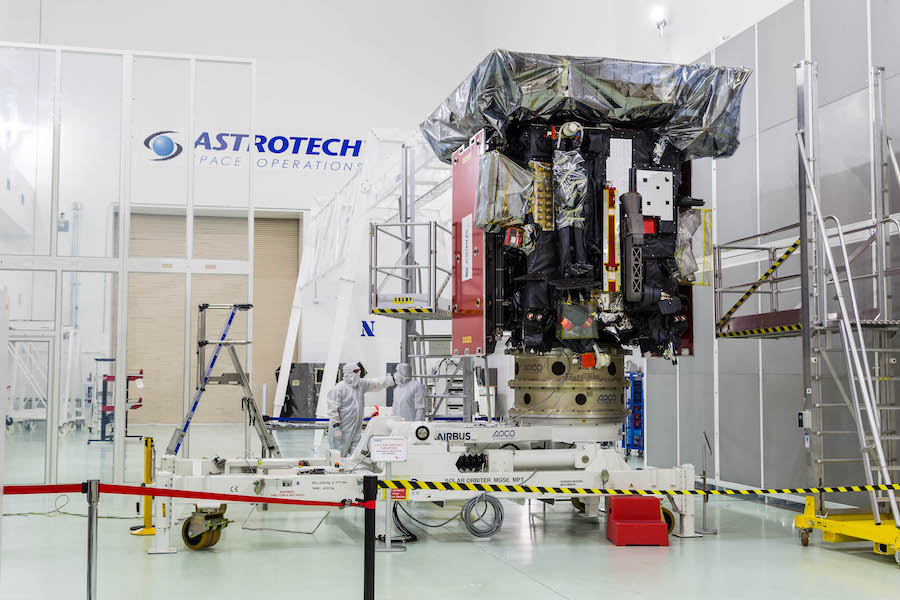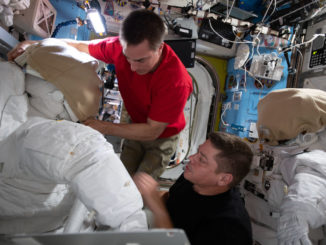United Launch Alliance teams began stacking an Atlas 5 rocket inside a vertical hangar at Cape Canaveral Monday in preparation for an early February launch with the Solar Orbiter spacecraft, a joint U.S.-European probe that will take the first pictures of the sun’s poles.
This week at Cape Canaveral’s Vertical Integration Facility, ULA technicians are assembling the #AtlasV 411 rocket that will launch @ESASolarOrbiter in its pursuit to study the Sun up-close. https://t.co/M26PyQCxKf#WeAreAllSolarOrbiters pic.twitter.com/PHIcM6RJ2v
— ULA (@ulalaunch) January 6, 2020
The bronze first stage of the Atlas 5 rocket — fitted with a dual-nozzle, Russian-made RD-180 main engine — was hoisted inside the Vertical Integration Facility at Cape Canaveral’s Complex 41 launch pad Monday after being trucked from the nearby Atlas Spaceflight Operations Center.
The stacking milestone at the VIF comes less than three weeks after the previous Atlas 5 launch Dec. 20, which sent Boeing’s Starliner crew capsule into space on an unpiloted test flight.
Liftoff of the Atlas 5 rocket is scheduled for Feb. 5 during a launch window that opens at 11:27 p.m. EST (0427 GMT on Feb. 6).
The Atlas 5, designated with the serial number AV-087, will fly in the rarely-used “411” configuration with a 4-meter-diameter (13.1-foot) payload fairing, a single strap-on solid rocket booster, and a Centaur upper stage with one Aerojet Rocketdyne RL10 engine.
The launch next month will mark the 82nd flight of an Atlas 5 rocket, and ULA’s first flight of 2020. It will be just the sixth flight in the Atlas 5-411 configuration, which is unique among large satellite launchers because it lifts off with asymmetrical thrust, thanks to the rocket’s use of a single side-mounted solid-fueled booster.
Later this week, ULA ground crews at Cape Canaveral plan to install the Aerojet Rocketdyne-made solid rocket booster to the Atlas 5’s first stage, then hoist the Centaur upper stage atop the rocket. That will complete the initial build-up of the Atlas 5 before technicians power up the rocket for testing and roll it to pad 41 later this month for a wet dress rehearsal, during which the launch team will load first and second stages with kerosene, liquid hydrogen and liquid oxygen propellants during a mock countdown.
After completing the simulated countdown test, the Atlas 5 will be returned to the VIF for attachment of the Solar Orbiter spacecraft, which is being readied for launch in a clean room at the Astrotech payload processing facility in nearby Titusville.
Built by Airbus Defense and Space in Britain, the Solar Orbiter mission was developed by the European Space Agency. NASA is partnering with ESA on the mission by paying for its launch on a U.S. rocket.

Ten scientific instruments aboard Solar Orbiter will measure the sun’s output and take the first detailed images of the sun’s poles.
Scientists will use data from Solar Orbiter, in tandem with measurements from NASA’s Parker Solar Probe, to better understand what causes the solar wind, and what drives the 11-year solar cycle.
“Solar Orbiter is clearly a new class in its own,” said Günther Hasinger, director of ESA’s science program. “It has loads of instruments, which will go not as close as Parker Solar Probe, but quite close. Solar Orbiter will also have eyes.
“Parker Solar Probe can only sense and measure the plasma and the magnetic field, but Solar Orbiter also has six instruments that can really look at the sun, which is quite a challenge when you think it is reaching an environment where it’s about 600 degrees Celsius (1,100 degrees Fahrenheit). It’s like being in a pizza oven, so you have to make sure that you don’t burn the instruments.”
Email the author.
Follow Stephen Clark on Twitter: @StephenClark1.



